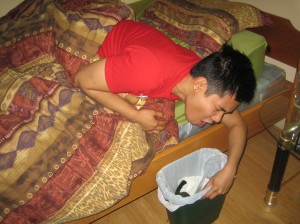There are plenty of first aid mistakes that have been passed from one

generation to the next. Some of these folklores of first aid come out from a state of panic in case an accident or emergency arises. However, instead of helping, these common first aid mistakes might cause more harm to the victim. Thus, it is very important to correct these mistakes. The following are the most common mistakes in administering first aid:
Mistake: If a person swallows a poisonous substance, immediately induce vomiting with ipecac syrup.
- Reality: Vomiting should not always be induced and might even cause more harm.
- Proper approach: Call the Poison Control Center immediately and do not give anything to eat or drink unless advised to.
Mistake: In cases of car accidents, move the injured away from the scene immediately.
- Reality: Some victims may not necessarily appear badly injured but actually have head, neck or spinal cord injuries, which may be aggravated upon movement.
- Proper approach: Move victim only if absolutely necessary, such as the scene becoming unsafe by fire. Initiate CPR if necessary but this should be done on a flat, hard surface. Otherwise, stabilize the victim and wait for emergency help to arrive.
Mistake: Apply a tourniquet on a bleeding extremity.
- Reality: Applying a tourniquet will stop the flow of blood, which may lead to permanent damage to a limb. Tourniquets should be used as a last resort.
- Proper approach: Apply first pressure to the wound using a sterile gauze or cloth. Wrap the wound securely. Seek medical assistance if bleeding doesn’t stop or if the wound is dirty or caused by an animal bite.
Mistake: Apply heat to a sprain, strain or fracture.
- Reality: Instead of limiting swelling, it does the opposite. Swelling will increase and may hinder healing process.
- Proper approach: Apply ice to the affected area for 15-20 minutes at a time. Do not apply ice directly to the skin.
Mistake: Apply butter to soothe a burn.
- Reality: Butter and other oils may make a burn more difficult to treat and more prone to infections.
- Proper approach: Run cool water for 15 minutes with a burn. For more severe burns, seek medical help.
Mistake: To thaw a cold extremity, use hot water.
- Reality: Hot water can burn the skin or cause further damage.
- Proper approach: Gradually warm the water by soaking the affected area in lukewarm water.
Mistake: Sponge rubbing alcohol on the skin to reduce a fever.
- Reality: The skin can absorb the alcohol, which may lead to alcohol poisoning, particularly in children.
- Proper approach: Take ibuprofen to decrease fever. If high fever continues for days, seek medical help.
Mistake: If a foreign substance enters the eye, rub the eyes and allow tears to wash substance out.
- Reality: Rubbing the eyes could cause a corneal abrasion or scratch.
- Proper approach: Rinse the eye with tap water.
Mistake: For cuts or scrapes, apply first aid ointment and cover with bandage. Leave it for a few days.
- Reality: Fresh air allows wounds to heal. Applying creams and ointments are not generally recommended as they leave the wounds moist. Bandages should be changed often.
- Proper approach: Wash the wound with cool water and soap. Change dressings twice a day, at bedtime and upon waking. Ensure that circulation is maintained.
Mistake: Allergic reactions to bee stings can be treated and managed at home.
- Reality: Respiratory allergic reaction to a bee sting could be life-threatening, especially if professional treatment is delayed.
- Proper approach: Call for emergency medical services immediately.
Mistake: Place chopped off body parts in a bag of ice.
- Reality: Ice can kill the nerves on the chopped body part and cause permanent damage.
- Proper approach: Wrap the severed part in damp gauze and place in a watertight bad. Place this bag on the ice and bring to the emergency room.
Most have probably heard at least one of these common first aid mistakes, be it from parents or other friends. It is necessary to avoid these mistakes to avoid causing further damage. These common first aid mistakes can be prevented by taking First Aid Courses with St Mark James Training.
Online Sources:
http://www.redcross.org/email/safetynet/v1n9/firstaid.asp
